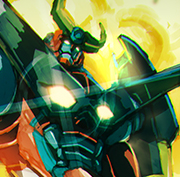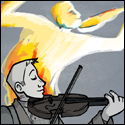|
ProfessorCirno posted:And this happens because this hobby doesn't care. There's this thought of "oh if it's broken, I'll just fix it." Actually, that's being covered by an even worse attitude of "it SHOULD be broken so people HAVE to fix it." People now do care - they just think things SHOULD be hosed. You get it a lot on ENWorld and some on WotC forums - the idea that games need to have big flaws in order to "teach" DMs how to mend their systems. "I miss when every AD&D table was unique!" That...that doesn't make any sense. That's like, I dunno, buying a board game and having to make up a missing piece of the board yourself. Why would you want to make a deliberately flawed system?!
|
|
|
|

|
| # ? Jun 3, 2024 00:47 |
|
Davin Valkri posted:
Because you're a poo poo game designer that doesn't know what the gently caress, you're just trying to sell the feel of a game that you played 30 years ago. It's pretty common.
|
|
|
|
Davin Valkri posted:
Why would you want to buy a house that requires you to put more money and effort into restoring it and fixing it up? Some people want to buy a fixer-upper though. The problem is that a lot of gamers conflate "had fun with a game despite having to patch/work around the bugs" with "had fun with a game because of having to patch/work around the bugs." Then this gets enshrined as part of the One True Way to Pretend-Elf, along with the technically correct but still disingenuous notion that "perfect balance is impossible!" and to a lot of roleplaying gamers having to shore up deficiencies in a game is considered a true and proper part of the charm.
|
|
|
|
Literal, actual cargo cult gaming.
|
|
|
|
Gau posted:Literal, actual cargo cult gaming. 3.x is cargo cult gaming personified. The entire engine is based around using the d20 and not actually knowing why outside of "AD&D did it!"
|
|
|
|
The thing is, houseruling and adapting are both fun and part and parcel of the hobby. Every group is going to adapt some of the rules to work differently with their group, and that's great, it's one of the strengths of the hobby. The problem is, so many of these companies take that as license to make it necessary to do just that. Instead of trying to adapt games to suit your taste or the playstyles of your group, you end up having to fix glaring errors just to make the drat thing work at all, and that's terrible. Rule Zero is fine and all, but it should be a case of adaptation, not outright having to fix the drat thing.
|
|
|
|
ProfessorCirno posted:3.x is cargo cult gaming personified. The entire engine is based around using the d20 and not actually knowing why outside of "AD&D did it!" What's the difference? I've seen you mention this a couple of times and I don't get why a flat distribution in 3e is different from a flat distribution in 2e.
|
|
|
Arivia posted:What's the difference? I've seen you mention this a couple of times and I don't get why a flat distribution in 3e is different from a flat distribution in 2e. This is just off the top of my head though, I'm not sure what Cirno meant.
|
|
|
|
|
Arivia posted:What's the difference? I've seen you mention this a couple of times and I don't get why a flat distribution in 3e is different from a flat distribution in 2e. The cap. This is a discussion happening at the Next thread, so I'll try to transplant it here. AD&D - and OD&D - was built around the d20. Take saves for example. Roll a d20, try to roll above your save score. This means that every +1 translates out directly to a 5% greater chance of success. You look at your sheet, you see your save, you know precisely your chance to not die when a medusa stares at you and you aren't using a mirror or whatever. Same goes for skills - roll below your attribute, or attribute + NWP if you're using those. "What's my chance to run across this tightrope? It's 14/20." Combat likewise was capped. AC started at 10 and ended at -10 (though a few special enemies, like the eldest of all dragons, could go past -10). THAC0, your chance to hit, started at 20 and went down to 1. I'm a fighter wearing platemail, giving me AC1, so I'm feeling incredibly tough, because AC1 is halfway to the cap and is a mess to hit. 3e's goal was to take all those different things and put them into one mechanic - which is good. Flat out, simplifying things down to a more basic mechanic when those multiple mechanics weren't adding anything is a good thing. But 3e took out the cap. Let's rewind. AD&D, my fighter has a save vs death at 10. I have a 50/50 chance of succeeding - I know this. In 3e, I have a fort save of 7. What's my chance to succeed? I have no idea. On top of that, taking out the cap made some number skyrocket while others...didn't. To use skills as the example, having a dex of 14 and a strength of 16 means I have a 14/20 chance to succeed at "dex rolls" and a 16/20 chance to succeed at "strength rolls." If I have a tumble of +15, a climb of +30, and a swimming of -1, what on earth are my chances to succeed at, uh, anything? Not only do I not know, but I have a character that can climb to the top of the mountains of hell, but drowns in a small puddle. Saves follow the same route - if I have a fortitude save of +20 and a will save of +4, not only do I not know my chances of succeeding in a saving throw, but I do know that I may as well not bother for will. Then we hit combat and jesus christ. That platemail is now essentially pointless. There are so many bonuses and additions, and that platemail doesn't mean crap. 4e in some ways fixed this, and in some ways didn't. While not having any OFFICIAL cap, they did implement an unofficial one through their scaled challenges. Monster of x level will generally have x+/-y for their attacks and defenses depending on role. Skill checks of x level will generally have x+/-y for their DC depending on difficulty. That x+/-y was "the cap," so to speak, built to be on level with the player. The problem is that, well, it's unofficial and hidden; you still don't know your chances just by eyeballing yourself. EDIT: To trace this back, AD&D was built into the D20. AC goes from 10 to -10; a track of 20. THAC0 goes from 20 to 1. Saves go from 0 to 20. Attributes go from 3 to 18. All of this follows the d20. But in 3e, nothing follows the d20. The d20 is just there because AD&D did it, and the math subsequently goes to hell because the d20 is super swingy on its own. SECOND EDIT: to translate this to 3e, it's the equivalent of +20 being the highest any modifier to any dice roll can go, and 30 is the highest DC or AC possible outside of titanic challenges or enemies. ProfessorCirno fucked around with this message at 10:21 on Jun 6, 2014 |
|
|
|
TheSoundNinja posted:There was a discussion a couple of pages ago about magical girl / Sentai transformation sequences and whether or not to give them a mechanical presence in the rules. Figured I'd throw my two cents in on the matter. It's been interesting comparing approaches to other and seeing the differences between the people who believe there needs to be a difference between transformed and untransformed states explicitly called out in the mechanisms and those (like me) who believe it already implicitly exists in the fiction and such mechanisms aren't necessary. I think both approaches're perfectly valid--they reflect different philosophies that can make for different but equally good magical girl games (and I believe those philosophies will lead to other differences as well). That said, thanks to this discussion I do intend to include a note about the transformation and how it (and other factors) influence what moves you can trigger. This kind of judgment of factors already exists in the Apocalypse World; it's just a particular case where it needs to be called out as something that's happening. Anyway, what you described is an interesting method of introducing sentai transformations into a game that didn't already have it. I enjoyed reading it and the other discussion on this matter. EDIT: To give an idea of where I'm at, I need to finish refining the basic moves, filling out the mostly complete playbooks, and write up the GM section. In short, a lot of work's already been done. Kaja Rainbow fucked around with this message at 11:10 on Jun 6, 2014 |
|
|
|
ProfessorCirno posted:SECOND EDIT: to translate this to 3e, it's the equivalent of +20 being the highest any modifier to any dice roll can go, and 30 is the highest DC or AC possible outside of titanic challenges or enemies. Christ, that is actually what looks like one of the simplest loving fixes. I mean, yeah, there's some other poo poo that'd need adjusted, but holy poo poo, you slap this on, and it'd fix a whole hell of a lot of poo poo. Go back to caps. Put maxes on stats again. Max of the number of spells a wizard can know or have in his spellbook.
|
|
|
|
ProfessorCirno posted:See, the 3e playtests - and the Next playtests, and the inner PF playtests - all have the same problem. They're not testing. They're just playing. I mean, there's already been some reports that the inner WotC playtests for Next have them houseruling things and not adding this to the actual game. It wasn't just that Gygax played the hell out of D&D, almost literally as much as one human could. It was that he playtested with wargamers who were straight up playing to win. None of this "Roleplaying not Rollplaying" nonsense used as an excuse. They were playing to win and everyone knew that, accepted it, and would gleefully drive an entire wagon full of cheese straight through any mechanical mistakes Gygax made. (Doesn't mean wargamers will find all the exploits - see Ogre or Starfleet Battles for details - but they are going to try). The big problem of oD&D was the part of the playtest Gygax didn't do. There was no blind playtesting that I'm aware of. Which is why some of it looks so ... inelegant.
|
|
|
|
Another thing about playtesting is that there seem to be two kinds. The first is just checking to see if the rules can be played. Can you read the rules and play the game? Are things clearly explained? Are there any contradictions in the rules? Any undefined terms? Any missing sections? Any unwritten assumptions? Can someone sit down and make a character or run a combat or research a spell based on the text of the rules, or do they throw up their hands in despair because none of it makes sense? Most games manage to pass this test, more or less. The second is to test if the rules (once you get them into a functional enough state to pass the first kind of playtesting) do what you want them to do. Do they incentivize the right behavior? Do they give everyone a chance to have a good time? Do they support the game's obstensible themes? Is it fun? Most games really do fail this test, because most game designers can barely articulate what they want their games to be - or if they do, they never express it in the rules, so you end up with a bunch of unspoken assumptions about how the game is supposed to play that aren't reflected in the rules. So you end up with things like 7th Sea, the game of cinematic swashbuckling that greatly punishes you for doing anything cinematic or swashbuckling by taking away your XP. It's like in software engineering - it's one thing to have your program compile successfully, it's another to have it successfully do what you want it to do. Or a video game, where it's one thing to have a game install successfully and run without crashing or glitching and another to have gameplay that is fun and balanced and compelling on top of that. FMguru fucked around with this message at 13:19 on Jun 6, 2014 |
|
|
ProfessorCirno posted:The cap. This is a discussion happening at the Next thread, so I'll try to transplant it here. In addition 4e has swingier math. It's quite possible for two 30th-level characters to have more than the range of the dice between their basic attack modifiers because stats directly determine combat effectiveness. This is balanced by at-will powers for some classes, but not all of them.
|
|
|
|
|
Effectronica posted:It's quite possible for two 30th-level characters to have more than the range of the dice between their basic attack modifiers because stats directly determine combat effectiveness. Can you give us an example of this?
|
|
|
Gort posted:Can you give us an example of this? Yeah. Any class which can dump strength and doesn't get magic weapons or expertise feats will have +17 on strength rolls (-1 base, +0 at level 21, +15 for half level, +2 proficiency), while prioritizing strength, having a magic weapon, and expertise will get you (+5 base mod, +4 from increases, +3 proficiency, +3 expertise, +6 item, +15 half level) +36 to strength rolls. 19 different before I go through and find feats to give me a +2 feat bonus and take me to 21 different. This is extreme, but lesser examples crop up more often. (Bards, Swordmages)
|
|
|
|
|
It never bothers me when a Bard is pretty lovely at stabbing someone with a sword, but the idea that dude who's so magical with his sword he can loving teleport people and shoot lightning can't take advantage of an opening is pretty ridiculous.
|
|
|
|
Gort posted:Can you give us an example of this? Hmm... My total difference between a fighter (Knight) who was Str 20 at level 1, and a Wizard who was Str 8 at level 1. +6 (base stat difference) +3 (six boosts to Str for the fighter by level that went to the wizard's int) +1 (Epic destiny stat boost) +1 (Fighter weapon talent) +1 (Sword vs staff) +1 (Stance) +6 (+6 weapon vs non-magical staff) +1 (Misc bonus) = +20 So yes it is possible. In theory. But let's look at the equivalent in 2E - Level 20. The Wizard has a Thac0 of 14, the fighter 0. The fighter is then carrying a +5 sword (because why wouldn't they?) and the wizard has a non-combat staff. We've now a 19 point difference even before we've taken strength and weapon specialisation/mastery into account. Hell, level 10 in 2E is IIRC a 7 point THAC0 difference. Weapon Mastery brings that up to a 10 point difference. +5 sword (again - this time the fighter is a lucky sod). 15 point difference. Girdle of Giant Strength comfortably pushes us to a 19 point difference. At level 10. Of course that's a lot of modifiers that weren't in oD&D. The claim that AD&D (post UA) is less swingy this way than 4e is thus shown to be risible.
|
|
|
|
Has there ever been a version of D&D that didn't fall apart at the higher levels?
|
|
|
|
Evil Mastermind posted:Has there ever been a version of D&D that didn't fall apart at the higher levels? B/X
|
|
|
|
50 Foot Ant posted:Another thing I've noticed is some playtesters complain if things are too easy. We included archetypes in the original version to get new players up and running, and people who ran the math on the archetypes found out that you couldn't build one of the archetypes with the base rules because the archetypes had more skill points and feats then you could make, but they were extremely focused, which was something else that people complained about that were long time gamers, that the archetypes were over-specified. There's a weird 'pride of system mastery' thing that seems almost as if they don't want new players to have a chance to be as good as their characters. As someone who wouldn't know system mastery from a hole in the ground, I look to archetypes as a guide for what I should aim for in chargen: number of skills and ranks, attribute ranges, etc. If they're super-specialized, I'll assume that's how the game is intended to be played. If they don't work mathematically, then I'm at a loss. In one game, it may have been an early edition of Shadowrun or the build point system, the designers came out and said some of the archetypes didn't fit the chargen parameters. I still don't understand what the point of that was-- it seems like an indictment of the system if the pregens are already breaking it. Mutants and Masterminds, as much as I love it, has some of the worst character archetypes I've ever seen. They show none of the math, and while they're all built to the same point value there's a radical disparity in power levels-- some are simply ineffective against anything stronger than normals or mooks, which is a problem if you pick that and the GM only throws full-blown villains at your party. The missing math is particularly frustrating when the archetypes use things like the Trade-Off system, which is tucked away in an easy-to-miss spot in the chargen pages, to bugger with stat caps. quote:To this day I wish I'd included the archetypes section to get people up and running really quick, or kept the 'fast generation' system that I'd come up with that people complained 'made everything too easy' because it didn't punish people who lost their characters in a high lethality game. I hope I never meet any of these people. Anyone who wants players to be 'punished' outside of the game for mistakes or poor luck inside is having serious difficulty separating one from the other. Honestly, if I'm expected to spend a lot of time and effort in chargen, I'm going to expect that (barring persistent stupidity on my part) characters will be pretty darn durable. Call of Cthulhu never worked for my group because chargen was awkwardly unfamiliar and PC death was very common, making the whole thing an ordeal. Basic D&D was a meat grinder, but one where you rolled 3d6 down the line, picked a few pieces of equipment, and were ready to roll inside of ten minutes.
|
|
|
|
We have always been at war with Faerun.
|
|
|
neonchameleon posted:Hmm... that's true for the case I used, but the numbers are more modifiable in 4e. You can eliminate half the gap by magic weapons and expertise feats, yeah, but spreading your ability increases around and not using expertise feats can create significant differences in effectiveness between identical classes and gear. This isn't a factor in ad&d
|
|
|
|
|
Bieeardo posted:Mutants and Masterminds, as much as I love it, has some of the worst character archetypes I've ever seen. They show none of the math, and while they're all built to the same point value there's a radical disparity in power levels-- some are simply ineffective against anything stronger than normals or mooks, which is a problem if you pick that and the GM only throws full-blown villains at your party. The missing math is particularly frustrating when the archetypes use things like the Trade-Off system, which is tucked away in an easy-to-miss spot in the chargen pages, to bugger with stat caps. Evil Mastermind fucked around with this message at 15:38 on Jun 6, 2014 |
|
|
|
Effectronica posted:that's true for the case I used, but the numbers are more modifiable in 4e. You can eliminate half the gap by magic weapons and expertise feats, yeah, but spreading your ability increases around and not using expertise feats can create significant differences in effectiveness between identical classes and gear. This isn't a factor in ad&d Unless using speciality priests... And what is a factor in AD&D is that the thief and the 1e monk are both terrible classes as written. Especially at low levels.
|
|
|
|
Bieeardo posted:
The most egregious of these is probably the construct archetype in the 3E book, which has no stamina score. Not just stamina 0, but actually no stamina, which means it's a PC archetype that can't use extra effort. (As a bonus "Constructs have no stamina" is basically one of the last dumb 3.xisms that M&M clings to, and even 3.x D&D abandoned it for PC constructs. ) unseenlibrarian fucked around with this message at 15:48 on Jun 6, 2014 |
|
|
neonchameleon posted:Unless using speciality priests... I wonder if anyone ever used "priests of other mythoi" beyond making clerics who can wield swords. And yeah, the only cool thing about the 1e monk was the level titles.
|
|
|
|
|
Evil Mastermind posted:There's also the fact that the designers completely screwed up the math for the pregens in the first edition book. Then, when people pointed out that the sample characters were made wrong, the eratta'd them with new build which where also built wrong. I think they got it right on the third try, but it's been a while so I don't remember exactly. You could probably count the number of RPGs where the pregenerated characters weren't some degree of A). badly made or B). incorrectly made on one hand.
|
|
|
|
unseenlibrarian posted:The most egregious of these is probably the construct archetype in the 3E book, which has no stamina score. Not just stamina 0, but actually no stamina, which means it's a PC archetype that can't use extra effort. God, the 'missing stat' rules are such a pain in the rear end. Every time I'm involved with M&M chargen and someone wants to make a robot, I strongly suggest that they play a little more 'let's pretend' and just stat a normal character with Life Support. Effectronica posted:I wonder if anyone ever used "priests of other mythoi" beyond making clerics who can wield swords. And yeah, the only cool thing about the 1e monk was the level titles. We only ever used the pre-statted ones from the Forgotten Realms hardcover and later books like Faiths and Avatars, not that they were balanced individually or as a whole.
|
|
|
|
Kai Tave posted:You could probably count the number of RPGs where the pregenerated characters weren't some degree of A). badly made or B). incorrectly made on one hand.
|
|
|
|
Bieeardo posted:We only ever used the pre-statted ones from the Forgotten Realms hardcover and later books like Faiths and Avatars, not that they were balanced individually or as a whole. I loved the whole Faiths and Avatars run (and made extensive use of the priests within) but I was a bit surprised to note that any priest of Bane or a Bane-like god (Cyric, Xvim, a couple of others) could summon an aerial servant at level 5 and command it to kill their enemies. A bunch of heroic PCs tackling a 5th-level priest of Cyric would be level 3-5 themselves, and an aerial servant had sixteen hit dice. I can only assume that some chump priest of Bane summoned one in a tie-in novel so the writers decided that clearly this was a thing that should happen in-game as well.
|
|
|
|
neonchameleon posted:The big problem of oD&D was the part of the playtest Gygax didn't do. There was no blind playtesting that I'm aware of. Which is why some of it looks so ... inelegant. That's why Basic is so great; it's designed to teach people how to play D&D every literal step of the way, whereas AD&D doesn't exist.
|
|
|
|
Gau posted:It never bothers me when a Bard is pretty lovely at stabbing someone with a sword, but the idea that dude who's so magical with his sword he can loving teleport people and shoot lightning can't take advantage of an opening is pretty ridiculous. Swordmages can take a feat to MBA with intelligence rather then strength. Bards don't really use MBAs. EDIT: And most characters, if they truly do care about basic attacks, can take Melee Training to get the same.
|
|
|
|
potatocubed posted:I loved the whole Faiths and Avatars run (and made extensive use of the priests within) but I was a bit surprised to note that any priest of Bane or a Bane-like god (Cyric, Xvim, a couple of others) could summon an aerial servant at level 5 and command it to kill their enemies. That one was a huge WTF for me, and it was even worse with one group that insisted on playing evil characters because the cleric would always go for Cyric. Lotta fun having an invisible sword of Damocles hanging over your already fractious party like that. I can't remember if they fixed it for Faiths and Avatars, but the FR handbook had an utterly haphazard assignment of priest spell spheres to gods. Some demigods had more spheres than greater gods, others had or were missing spheres that made no sense, and it really looked like the writer just assigned them willy-nilly. That's before the even weirder 'balance' in granted abilities, which ranged from summoning invisible assassins to annoying the party mage by competing for his spell scrolls.
|
|
|
|
Kai Tave posted:You could probably count the number of RPGs where the pregenerated characters weren't some degree of A). badly made or B). incorrectly made on one hand. HoL. Assuming you don't have Buttery Wholesomeness, anyway.
|
|
|
|
DigitalRaven posted:HoL. I really need to find a copy of Buttery HoLsomeness. I only have HoL.
|
|
|
|
Error 404 posted:I really need to find a copy of Buttery HoLsomeness. I only have HoL.
|
|
|
|
Effectronica posted:Yeah. Any class which can dump strength and doesn't get magic weapons or expertise feats will have +17 on strength rolls (-1 base, +0 at level 21, +15 for half level, +2 proficiency), while prioritizing strength, having a magic weapon, and expertise will get you (+5 base mod, +4 from increases, +3 proficiency, +3 expertise, +6 item, +15 half level) +36 to strength rolls. 19 different before I go through and find feats to give me a +2 feat bonus and take me to 21 different. This is extreme, but lesser examples crop up more often. (Bards, Swordmages) Ah, can't happen in good 4e games then (the ones who use inherent magical bonuses like sensible GMs)
|
|
|
|
FMguru posted:ButtHoL not only has the greatest character random generation system ever, it also has the greatest set of LARP rules ever published.
|
|
|
|

|
| # ? Jun 3, 2024 00:47 |
|
Babylon Astronaut posted:Didn't Violence have LARP rules that were basically killing homeless people in abandoned buildings?
|
|
|
































